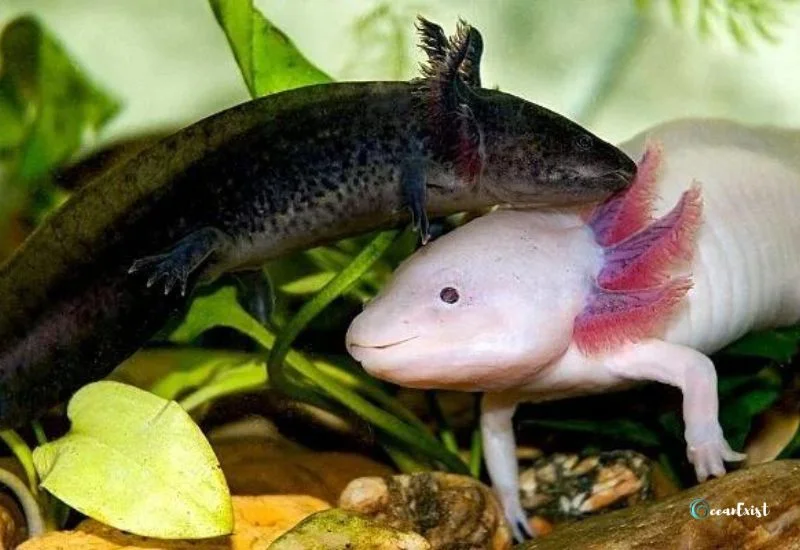Axolotls appear as if they are heavenly creatures. They are salamander amphibians that time has forgotten. That is why they are called “Peter Pan of Salamanders.”
Found in Mexico near Mexico City, axolotls are one of the endangered species. Experts call them species of laboratories, as a larger number of axolotls are found in laboratories than in ponds, aquariums, and oceans.
They can grow their gills naturally, making them one of the interesting morphs. Unaware of the start, but due to selective breeding and natural marvels, axolotl morphs come in different types and colors with different behaviors and rare elements.
Therefore, we have brought an interesting blog on nineteen types of axolotl color morphs with pictures and descriptions.
So, why not head to it quickly?
What Is an Axolotl?
Axolotl is a pedomorphic salamander that is closely related to tiger salamander. It is common in amphibians who go to adulthood with the process of metamorphosis. Axolotl live in water rather than taking over the land. Axolotl is broadly used in scientific research for its ability to regrow limbs and tails.
The Reasons for Color Variations
The color variation in axolotl can be due the genetics or a result of breed:
Melanophore
Lelanophore cells contain the pigment melanophore. This pigment causes the black pigmentation on the skin of amphibians, making their skin dark.
Xanthophore
These cells contain carotenoids that create yellow, orange, and red colors.
Iridophore
These cells make the crystal appear on the skin by forming a thin layer of reflective crystal substance within the skin. Amphibians with iridophore can have the effect of camouflage, which helps them blend in with the environment.
Different Axolotl Morphs With Rarity and Cost Chart
| Morph Type | Rarity |
| Albino | Common |
| Black Melanoid | Common |
| Chimera | Extremely Rare |
| Clear Axolotl | Rare |
| Copper | Uncommon |
| Dirty Lucy | Common |
| Enigma | Extremely Rare |
| Firefly | Very Rare |
| Golden Albino | Common |
| Green Fluorescent Protein (GFP) | Uncommon |
| Heavily-Marked Melanoid | Uncommon |
| High Iridophore | Rare |
| Lavender | Rare |
| Leucistic | Common |
| Mosaic | Very Rare |
| Piebald | Rare |
| RLG | Rare |
| White Albino | Common |
| Wild Type | Common |
1. Leucistic or White Axolotl
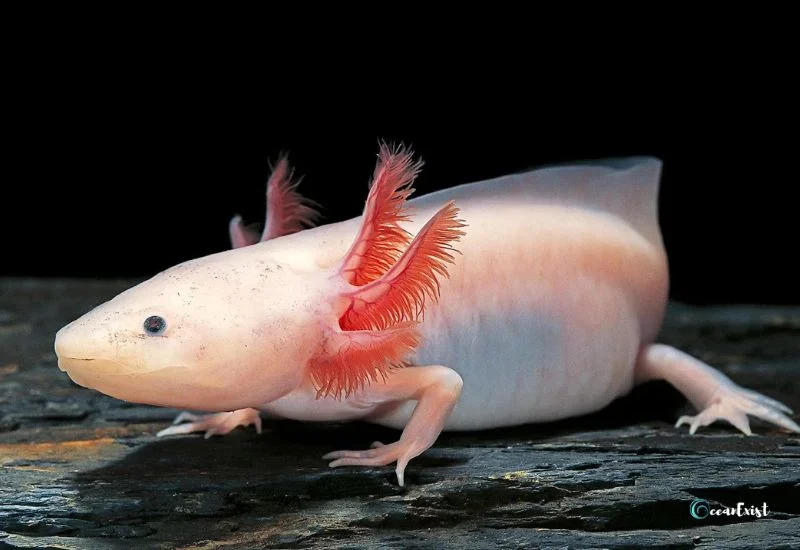
The Leucistic or white Axolotl is one of the most stunning morphs. They are translucent white shiny flecks. Primarily, they are characterized by their striking pure white or pale pink skin with pink or red eyes.
Having magical beauty, Leucistics are sometimes called mythical creatures. Having a white and shiny appearance, they are easily spotted by predators. It is rare and close to distinction.
But, when it comes to axolotl morphs, they are common ones.
Leucistics lack pigment cells. It gives them a unique appearance. Their ethereal beauty makes them highly sought after by enthusiasts and breeders alike.
2. Wild Type Axolotl
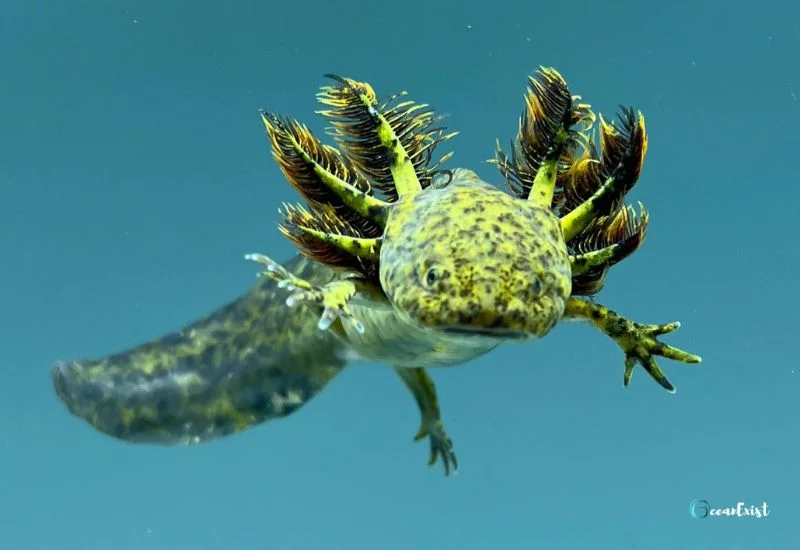
The Wild Type Axolotl represents the natural appearance of wild creatures.
They typically exhibit shades of brown, tan, olive, and sometimes even a hint of green. Their dark spots and markings are scattered across their bodies.
Their appearance reflects their habitat, blending seamlessly with the substrate of their native lakes and waterways.
Their eyes are dark colored with golden irises. Their bellies are light. And their gills are purple.
3. White Albino Axolotl

White Albino Axolotls are characterized by their pristine white or light pink bodies and striking ruby-red eyes. They are like Leucistic due to their white colors, but the only difference is they have albinism and have different gills colors.
White albino axolotls have little melanin but lack other pigments. It gives them a distinctive appearance. Lack of melanin causes them to be more sensitive to light, requiring shelter or shaded areas in their habitat.
However, white Albino Axolotls are hardy creatures. They captivate observers with their unique coloration and gentle demeanor.
4. Golden Albino
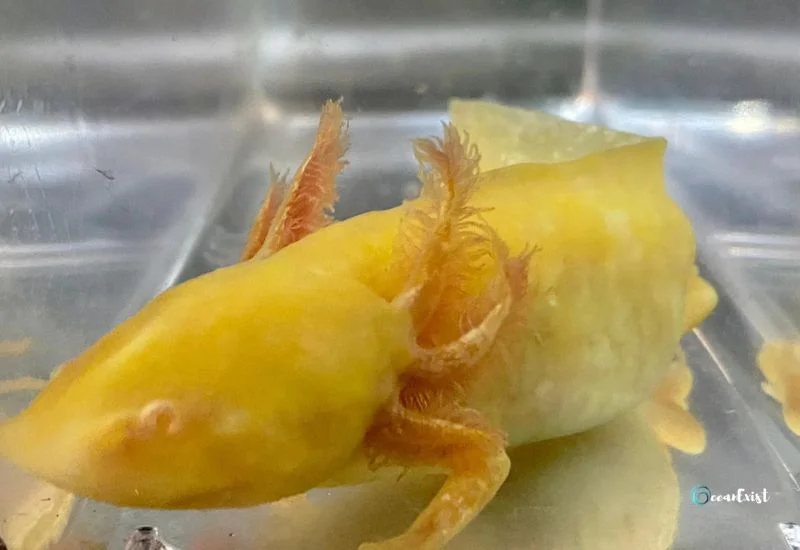
The Golden Albino Axolotl is a rare and enchanting morph. They have vibrant golden-yellow hues and mesmerizing red or pink eyes.
Baby golden albinos are white and translucent. As they mature, they get golden or other colors. The most common color golden albinos are found is golden.
However, their body may not be all golden and contain other colors.
Moreover, due to albino eyes, golden albinos are sensitive to light and might have vision problems.
5. Speckled Leucistic
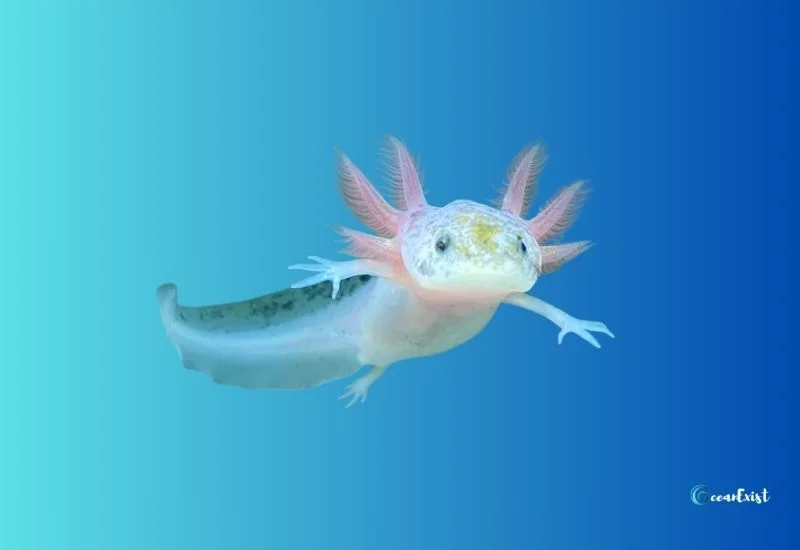
Speckled Leucistic Axolotls are a delightful type of leucistic morph. They are featuring a predominantly white or pale pink body. They have black, green, and dark speckles on their head, back, and tail.
These speckles can vary in size and density, creating a mesmerizing contrast against their light-colored skin. With different patterns, each Speckled Leucistic Axolotl has a different appearance.
Their patterns and speckles change with age growth, giving them a different appearance when they grow.
6. Black Melanoid
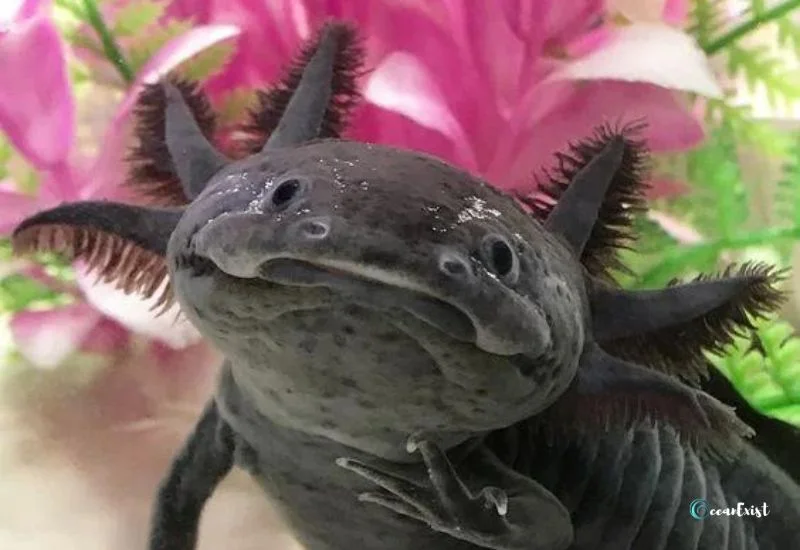
Black Melanoid Axolotl resulted from a mutation in 1961, but now they have become common. They have a deep black or dark brown body with dark purple gills and fins.
As they have solid colors, they do not have iridescent colors like many other morphs. This intense pigmentation sets them apart from other morphs.
Despite their dark appearance, they can change color like different aquatic environments. However, the color change is not permanent. As the surroundings change, they will change color to suit the environment.
7. Dirty Lucy
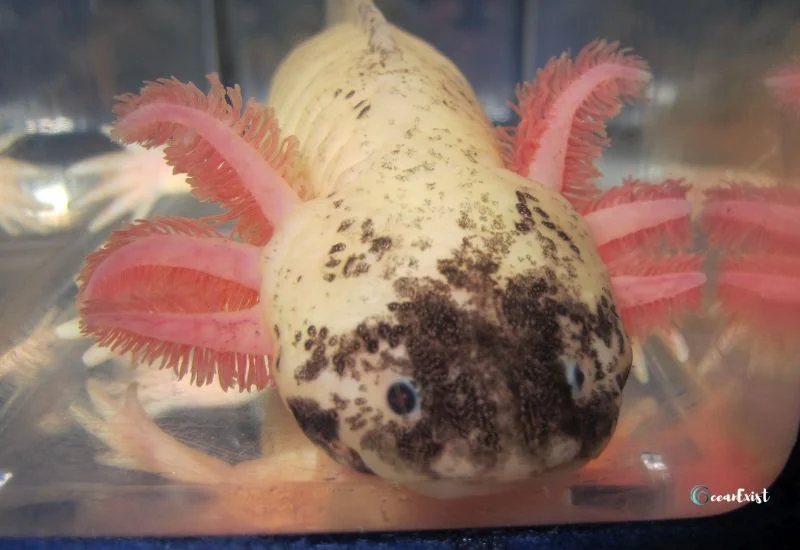
Dirty Lucy’s name for these fish is taken because of their appearance. Dirty Lucy is white with a few dark or brown speckles.
You can call these fish dirty leucistic or speckled Lucy because of their white and speckled appearance.
Due to the low proportion of chromatophores, their leucistic traits are similar to albinos. However, albinos do not have iridescent sparkles, nor can they produce dark colors that dirty Lucy can.
8. GFP Axolotl
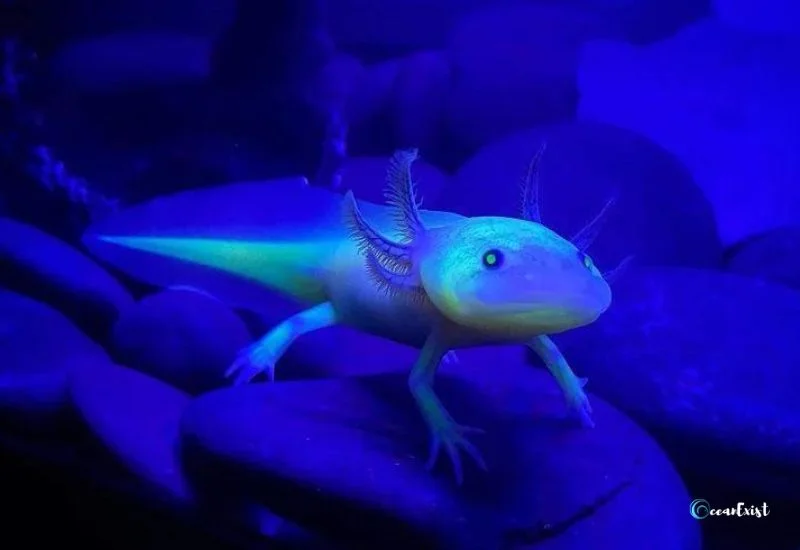
GFP Axolotls, or Green Fluorescent Protein Axolotls, is a marvel of genetic engineering. These came into existence when scientists studied axolotls’ ability to regenerate body parts. And now, GFP Axolotls have become the loving pet of every aquarist.
GFP Axolotls contain a fluorescent protein derived from jellyfish that causes them to emit a greenish glow under black lights.
GFP Axolotls can come in any color. However, the property that makes them GFP is their ability to glow in dark spaces.
9. Heavily-marked melanoid Axolotl
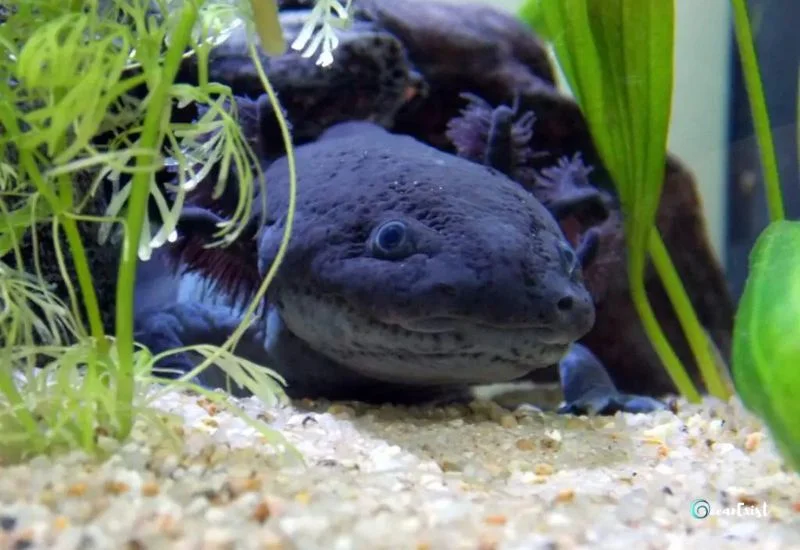
Heavily-marked melanoid Axolotls are a striking variation of the melanoid morph. Only the difference is due to the green spots across their body.
These markings can range from bold stripes and bands to intricate speckles and spots, creating a visually stunning tapestry of color and contrast.
However, Heavily-Marked Melanoid Axolotl is found only a few times. Making them one of the rare species.
Each Heavily Marked Melanoid Axolotl possesses a unique pattern of speckles and spots.
Despite their distinct markings, these axolotls retain their species’ gentle demeanor and hardy nature.
10. Firefly Axolotl
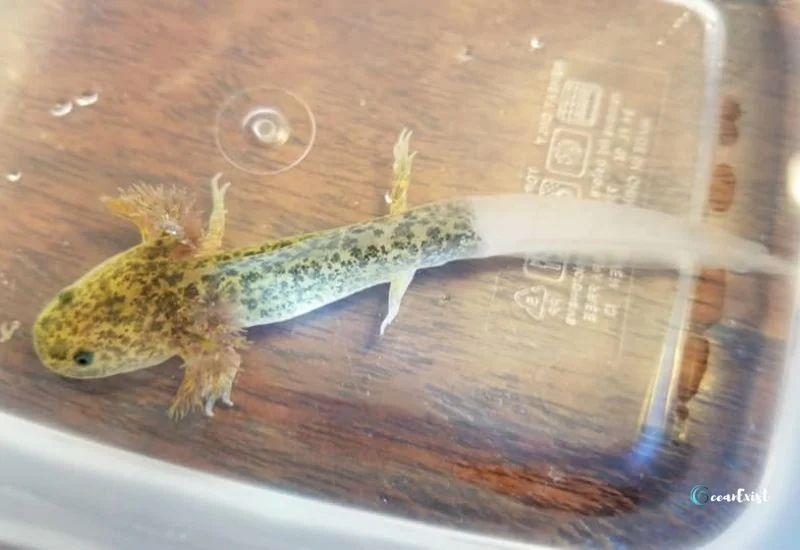
Firefly Axolotls are a dazzling morph that combines the vibrant fluorescence of GFP technology with unique pigmentation patterns. They cannot be bred and only come into existence in the laboratories.
They are created using embryonic grafting, where their tail is removed and later attached with a new albino tail that glows green. Under darker spots, only their tails glow, making them look like a firefly. Hence the name.
Firefly Axolotls come in different patterns and vibrant colors, ranging from electric greens and blues to fiery oranges and yellows.
Being the rarest, each firefly axolotl costs at least $1000.
11. Axanthic Axolotl

The Axanthic Axolotl types of morphs have a white or translucent appearance like other albino creatures.
Despite its albino classification, the Axanthic axolotl morph may exhibit light-colored speckles or even transition to a light shade of golden or yellow as it grows.
Apart from these qualities, they have pink or red eyes and gills, making their appearance elegant.
12. Mosaic Axolotl
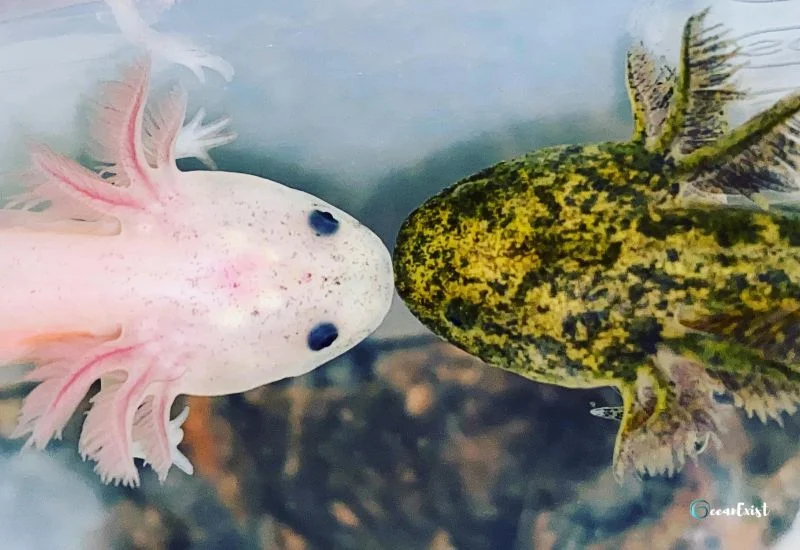
Mosaic axolotls are a fusion of two separate eggs. Therefore, they have complex colors and intricate patterns.
Each individual showcases a unique combination of white, black, gray, and pink hues. They create a stunning visual spectacle that also can be achieved by selective breeding. However, colors, whirls, and patterns can not be changed by mutation.
As one of the most sought-after morphs, they can have black, white, or pick-up specks of golden sparkles with red, pink, and olive stripes.
13. Piebald Axolotl
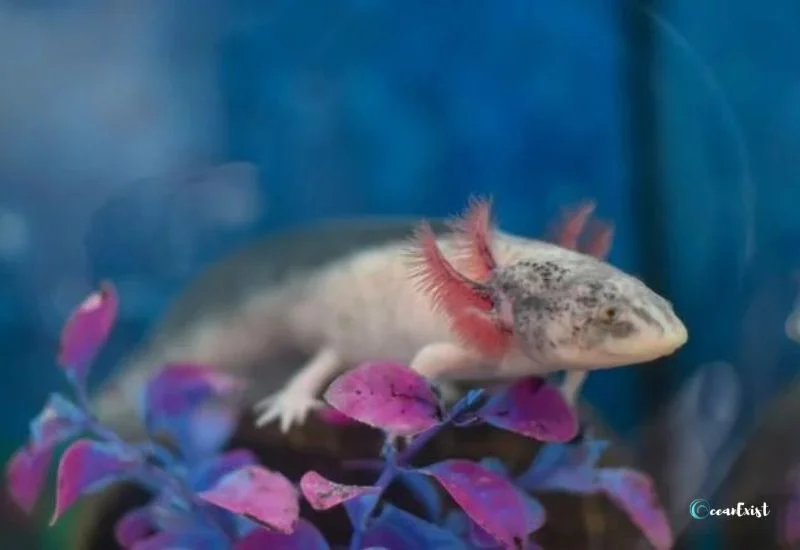
The Piebald Axolotl captivates with its distinctive white body adorned with bold black spots and streaks. They are the best option for aquarists requiring the rare and captivating morph.
Piebald axolotl resembles the mosaic morph in some aspects. However, the color splotches typically fade towards the tail, and mosaic splotches continue to the ends.
The patterns on piebald axolotl are stronger on the face and fade along the body. They have red gills and dark eyes.
14. Lavender Axolotl
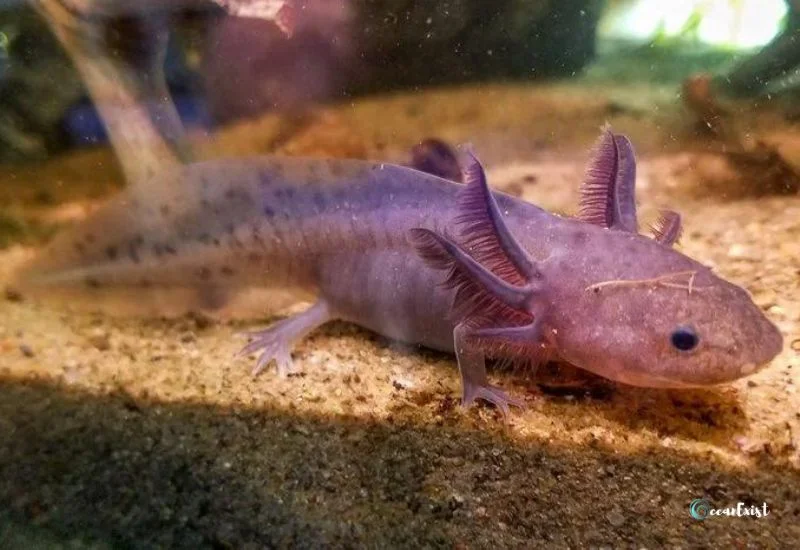
Lavender Axolotls are also called silver dalmatian axolotls because of the spots and patterns on their body.
Their purple appearance is rare and cannot be achieved by selective breeding. Lavenders are found in purple and silver colors. And, as they grow, some lavender axolotls can change their colors to darker shades.
Moreover, they have dark glitter eyes, adding a touch of beauty to their appearance. And their gills are ruby red. They can have lighter legs and lower sides. And, as it comes closer to the body, the color becomes darker.
15. RLG Axolotl
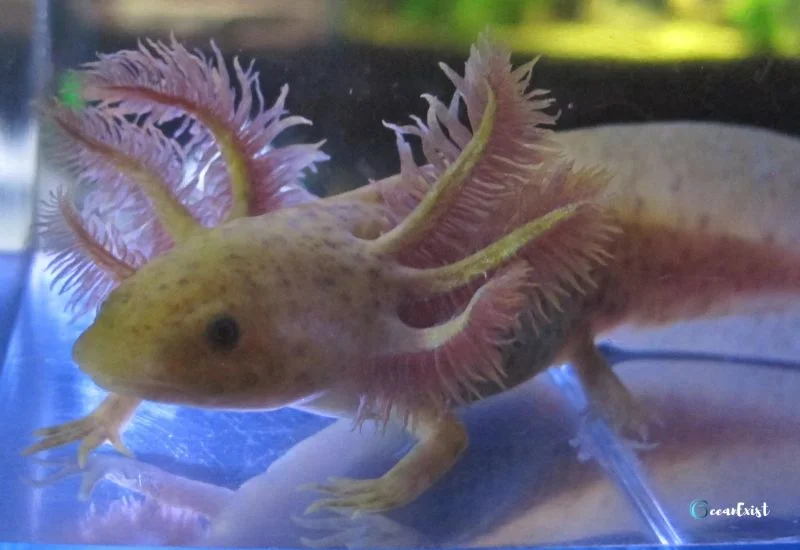
RLG Axolotls are known for long gills that wave lazily in the gentle currents of its tank. Their exceptionally elongated gills range from 1 1⁄2 to 2 inches.
With their graceful appearance and distinctive features, RLG Axolotls charm observers and enthusiasts, adding a whimsy touch to any aquatic environment.
These axolotls can be of any color, pattern, and morph, adding charm to their overall appearance.
16. Chimera Axolotl
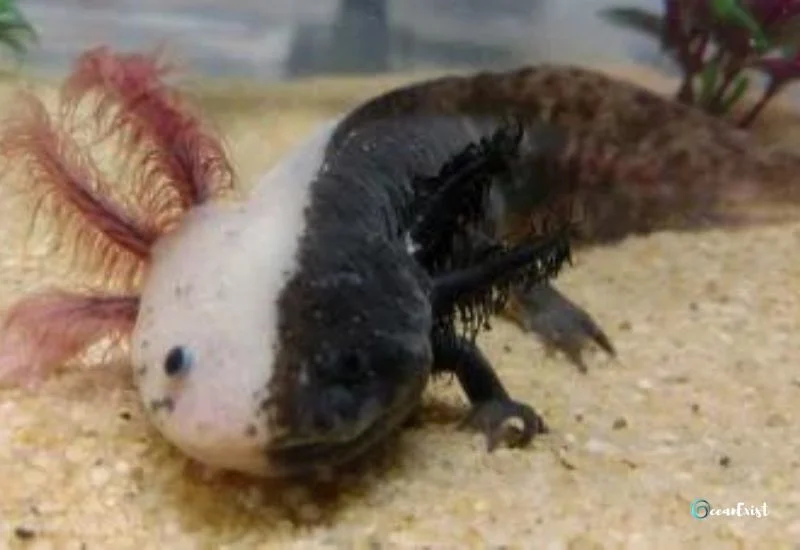
Chimera axolots are one of the most rare breeds. They are the result of fortunate or unfortunate birth marvels. These axolotls cannot even be achieved by selective breeding.
They are born from the fusion of two distinct embryos. Thus, they have two different sides, looking like two morphs are joined together. One side is white, and the other is black.
Most chimeras do not survive even infancy, and there are rare chances they live up to maturity. It makes them the rare type of axolotls. Despite their rarity and health challenges, they are the most sought-after breed.
17. Enigma
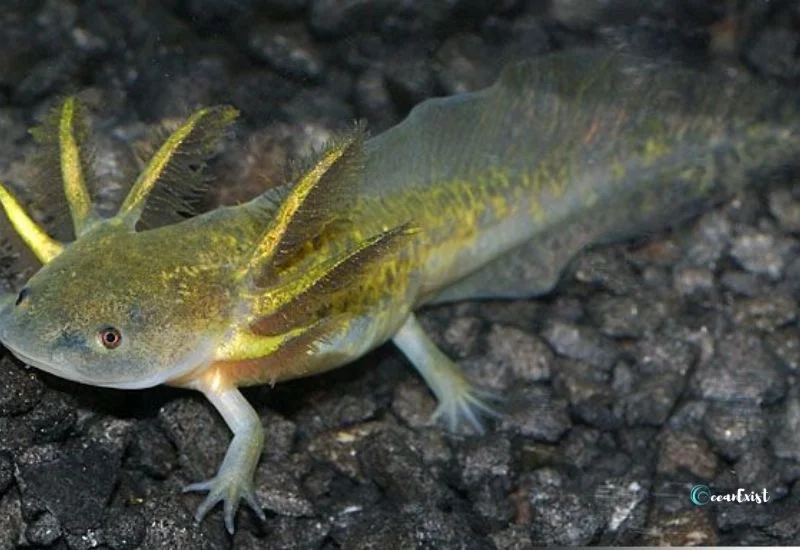
Enigma Axolotl are rare morphs shrouded in intrigue and allure. Their rarity gives them the name enigma, as very little is known about them.
They live in a situation where the color change is constant. They transition from deep black to yellowish-green and dark gray. Moreover, they have patches of glittering gold and are accented by pink gills and golden eyes.
The Enigma Axolotl remains a rare gem in the world of Axolotl enthusiasts. Aquarists are captivated by its mystique and allure.
18. High Iridophore
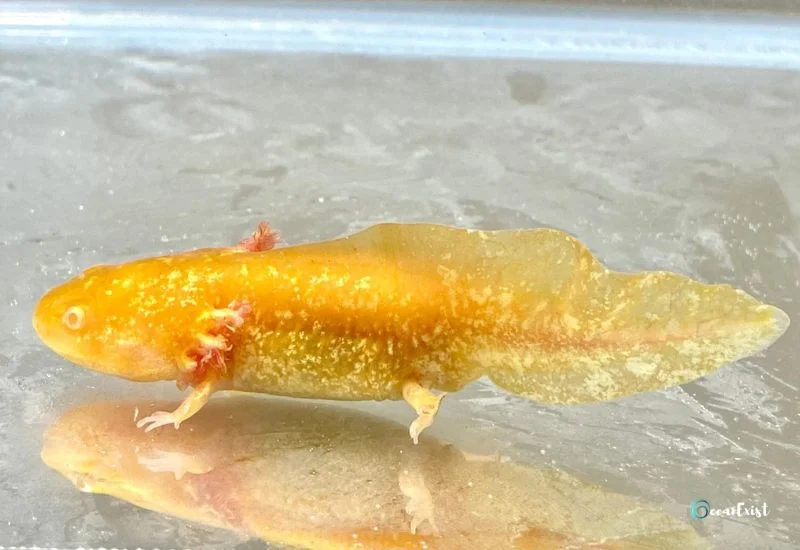
These axolotls have an abundance of iridophores, which are cells responsible for reflecting light and giving the skin a shiny, iridescent appearance. They are the brightest morphs.
High iridophores can be of any color and pattern, but their luminous appearance is common. Their gills take color from the original morph. If the morph is white, it will have white gills but with patches that glow.
This morph can result in axolotls with particularly vibrant and eye-catching colors.
19. Copper Axolotl

This morph refers to axolotls with distinct coppery coloration. It’s characterized by shades of brown, bronze, or reddish hues. It resembles the appearance of polished copper. But they have specks of gold, pink or white.
They have grey eyes with red irises and pink gills. Copper axolotls can exhibit various patterns and markings along with their unique coloration.
Care of Axolotl
Here are a few tips on how to take care of axolotl:
Maintain the Water Quality
The large tank is best for axolotl. The recommended amount of water per axolotl is 110 liters. Axolotl produces a lot of body waste, which can increase the amount of nitrite and nitrate in the water. To maintain the water quality, check and change the water in the tank at regular intervals. The axolotl can jump out from the water to prevent that and keep the water level a little lower in the tank.
Selection of Substrate
The axolotl can ingest the substrate. Try to avoid any small decorations, like gravel sand, which is the size of an axolotl. Adult axolotls can eat sand and pass it out without any issue, but it’s not the same for younger axolotls. We can not keep them on the sand until they are 6 inches long.
Habitat
It is essential to decorate the tank according to the needs of axolotls. Leave plenty of hiding places for them. Change the decoration of the tank from time to time to give them a new layout to explore. You can add live plants to the tank. Axolotl is sensitive to light make sure the intensity of light is not too high.
Conclusion
Now you completely know about different types of axolot morphs. Once an axolotl appears before you, you will identify it quickly.
This blog is no less than a treasure for the aquarists who take an interest in heavenly creatures, containing comparisons, price lists, rarity charts, and pictures of different types of axolotl morphs.
Add a comment or leave a suggestion.
Let us proceed on our journey to become aquarium experts with our next blog to learn about the different types of betta.
